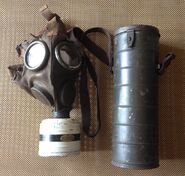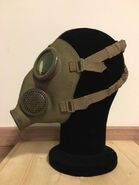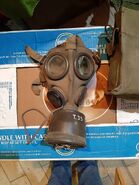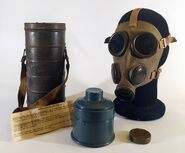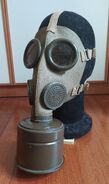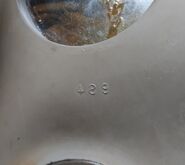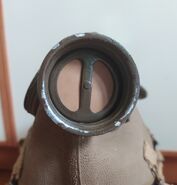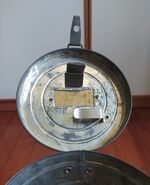The P43 is an Italian industrial and civilian gas mask. It's characterized by its unique double exhale valve system. It was produced in many different variants and it was exported to many countries.
Mask overview[]
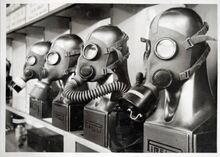
1934 air raid protection exhibition. From left to right: P45, T.33, P43 with a hose, P43
The P43 was produced in various ways with different furniture but always with the same setup, which consisted of:
- A flat-moulded faceblank, smooth on the inside and textured on the outside
- A threaded inlet at the chin with an inlet valve
- Two crimped eyepieces, 50 or 66mm wide, usually made of triplex glass. Early industrial P43, P44 and P45 masks could also be sold with simple glass lenses.
- Two exhale valves with identical housings, one for each cheek, with P44 and P45 masks having only one on the left cheek.
- A 5-straps head harness, four of which were elastic, similar to the later produced T.35’s
Variants[]
Industrial variants[]
The industrial P43s had various accessories available: the regular kit consisted of a Dirin filter, a tube carrier, a spare exhale valve and a stick of anti-fogging soap. Alternatively, the mask could be sold in a Pirelli metal box (32 x 21 x 13cm) with a larger filter (Tubin or Turnivercio), a hose and a cage carrier to carry said filter on the chest. A spare exhale valve and a stick of anti-fogging soap would also be included. If required, a rubberized hood could be attached to the mask, along with other minor adaptations (in which case it'd have the designation changed to S.I.P. 6).
Old-pattern industrial variant[]
The first types of P43 produced were made solely for industrial purposes. Its faceblank was made of a single layer of green rubber smooth on the inside and textured on the outside (the earliest production might have had only smooth rubber), the old-pattern 5-straps head-harness was attached. The lenses could be made of either Triplex glass or regular glass, depending on the buyer's preference. The exhale valves were of the VD 25 type, the same ones used with Pr.C. 33 masks later on. The thread of the filter was 30 mm. The eyepieces were smaller than in later models, 50mm compared to 60mm.
By July 1931, a P43 facepiece with one-layer lenses cost 26 lire, while one with triplex lenses cost 31 lire.
Note that due to the almost total resemblance to the P.C. 30, it's almost impossible telling them apart in a picture, save for context.
Updated industrial variant[]
Later industrial P43 masks were made with a new and improved setup. The faceblank was made with a layer of rubber, smooth on the inside and textured on the outside; the lenses were made of triplex glass and were larger than before (66mm instead of 50mm, though there's a picture of one that still has the smaller lenses), the head-harness was updated from the previous model and the exhale valves were different, more similar to the ones later used with the T.33 but without 4 corners. Updated industrial P43s can be easily told apart from civilian ones because of the size marking on the left cheek, which has no other marking.
Dedicated civilian/territorial variants[]
Civilian P43 masks were issued with a civilian or territorial filter (usually Dirzepo or Pir. 35 filters on later kits), a tube carrier, anti-fogging soap and a spare exhale valve in a small box. These variants all used the updated industrial facepiece setup, with minor differences such as the paint, the markings, the exhale valves and their covers.
Regular civilian/territorial variants[]
On the 26th of May 1934 the P43 was the 2nd gas mask approved by the S.C.M. (Servizio Chimico Militare, chemical military service) and started getting sold to civilians and territorial forces. See their manual here.
After the end of the war, some were repurposed and retailed as industrial masks.
Flat exhale valve cover variant[]
This variant had exhale valves that were dissimilar to most Italian mask, yet they are compatible with T.33-style exhale valves.
Round exhale valve covers variant[]
This variant had identical exhale valve covers but different exhale valves, which were the same later used for the T.33.
Telephonist variants[]
The P43, due to its double exhale valve arrangement, was especially suitable for the addition of a microphone, which would be usually put in place of the right exhale valve. This procedure could be done to any P43, but later on a dedicated type would emerge.
Generic type[]
As mentioned previously, any P43 mask could be converted into a telephonist's kit. In particular, the Italian civilian types that were issued with a microphone also featured a paper describing its use. The microphone could be of various types, the most common featured a star on its bakelite cover and could interface with Siemens-type and Western-type telephones.
Dedicated type[]
On the 27 of July 1939, the Mod.P43tf. was approved as the 29th gas mask approved by the S.C.M. (Servizio Chimico Militare, chemical military service) as a dedicated telephonist's mask. The mask was issued with a bag, a filter, a manual and a microphone, already installed in place of the right exhale assembly. The facepiece differed from earlier civilian types only by the markings and the top strap's locking system, changed to the more traditional buckle system used on military masks.
Derivatives[]
P44[]
main article: P44
The P44 was a cheaper variant of early P43s, it differed only in the lack of the rightmost exhale valve
P45[]
main article: P45
The P45 was an even cheaper variant of the P44, as the strap system was replaced with a 2-straps head harness system helped by two strings tied together around the neck.
P.C. 30[]
main article: P.C. 30
The P.C. 30 was the civilian variant of early industrial P43 masks. It had a 30 mm thread and smooth rubber.
P 531[]
main article: P 531
The P 531 was an improved variant of the early P43, with a Tissot system, along with other improvements.
S.I.P. 6[]
main article: S.I.P. 6
Some P43s had hoods permanently attached at the factory (along with other minor changes) and were designated as S.I.P. 6.
SAB P43[]
main article: SAB P43
The SAB P43-like series were variants of the P43 and P 531 produced by SAB for mainly industrial use.
Derivatives' Gallery[]
Export and foreign production[]
The P43 is confirmed to have been exported by Pirelli all over Europe and South America, with the Netherlands having the best reports of it being used. In Asia, the KMT adopted a dedicated P43 variant. Some masks might have been sold in Africa too, but it's not been confirmed. Some of Pirelli's production was on location, such as in Spain, Argentina and others.
Italian type (China)[]
main article: Italian type (China)
The Italian type, also known as Italian mask or Italian imported mask, is a military version of early-pattern P43s, produced and exported to China by Pirelli.
Ajax F1[]
main article: Ajax F1
The Ajax F1 was an Italian-licensed french-produced copy of the P43. It used a dedicated 42 mm filter. Save for its intake thread, it's identical to the updated industrial P43 variant.
L'Anti-Gaz P43 variants[]
During the early '30s, before the AG 5 and AG 10, L'Anti-Gaz produced two types of P43 variants, most likely for the civilian market or to appeal to the civil defence. The 25mm thread was not being used yet, and the carriers were rebranded Pirelli ones.
30mm variant[]
This variant of the early L'Anti-Gaz P43 sports a 30mm thread, VD 25 exhale valves (double disc exhale valves on later samples) and small eyepieces (50mm), resembling the first pattern of industrial P43s. The filter is very similar to an early-pattern industrial Dirin, it may have been made either in Italy or in Belgium.
40mm variant[]
This variant is slightly more modern than the 30mm one, as it has a 40mm DIN thread and AG 5-style exhale valves, but the eyepieces are still the small type. The 40mm thread might also mean that it was meant for export to the Netherlands, but there is no source to neither confirm nor deny this possibility. The filter is a slightly newer Dirin 500-pattern filter and, like the other one, it may have been made either in Italy or in Belgium.
AG 5/AG 10[]
main article: AG 5/AG 10
The AG 5 and AG 10 were the finalized variants of the Belgian P43s made by L'Anti-Gaz. They sported a 25mm thread.
Manuals[]
Manual for the Italian civilian types.
References[]
Links to all the sources for the information, including most links to the pictures
- http://users.skynet.be/flexaret/index.html?x=89&y=16
- https://archiviostorico.fondazionefiera.it/oggetti/3639-maschere-antigas-alla-mostra-della-protezione-antiaerea-della-fiera-campionaria-di-milano-del-1934
- https://aeropinakes.com/wordpress/1938/01/27/ganadores-y-perdedores/
- https://fortepan.hu/en/photos/?donor=Rekl%C3%A1m%C3%A9let%20foly%C3%B3irat
- https://www.env.go.jp/chemi/gas_inform/historical/1934_photo/pdf/06_chpt06.pdf
- Archivo General de la Nación Argentina
- GUERRA CHIMICA E DIFESA ANTIGAS, Attilio Izzo, 1931 edition
- 1931 Pirelli pricelist
- 1932 Pirelli catalogue
- 1935 Pirelli catalogue
- Federico Turci’s collection
- Gianmichele Erre's collection
- Viktor Ferrando's collection
- POLE34's collection
- Ramonchete's collection
- JeromeZP's collection






